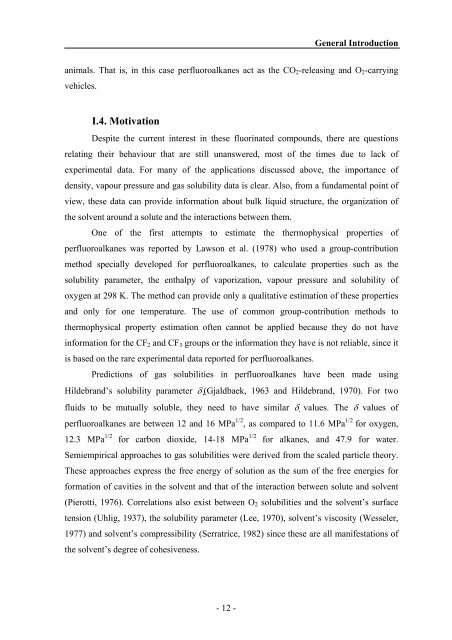n - PATh :.: Process and Product Applied Thermodynamics research ...
n - PATh :.: Process and Product Applied Thermodynamics research ...
n - PATh :.: Process and Product Applied Thermodynamics research ...
You also want an ePaper? Increase the reach of your titles
YUMPU automatically turns print PDFs into web optimized ePapers that Google loves.
General Introduction<br />
animals. That is, in this case perfluoroalkanes act as the CO2-releasing <strong>and</strong> O2-carrying<br />
vehicles.<br />
I.4. Motivation<br />
Despite the current interest in these fluorinated compounds, there are questions<br />
relating their behaviour that are still unanswered, most of the times due to lack of<br />
experimental data. For many of the applications discussed above, the importance of<br />
density, vapour pressure <strong>and</strong> gas solubility data is clear. Also, from a fundamental point of<br />
view, these data can provide information about bulk liquid structure, the organization of<br />
the solvent around a solute <strong>and</strong> the interactions between them.<br />
One of the first attempts to estimate the thermophysical properties of<br />
perfluoroalkanes was reported by Lawson et al. (1978) who used a group-contribution<br />
method specially developed for perfluoroalkanes, to calculate properties such as the<br />
solubility parameter, the enthalpy of vaporization, vapour pressure <strong>and</strong> solubility of<br />
oxygen at 298 K. The method can provide only a qualitative estimation of these properties<br />
<strong>and</strong> only for one temperature. The use of common group-contribution methods to<br />
thermophysical property estimation often cannot be applied because they do not have<br />
information for the CF2 <strong>and</strong> CF3 groups or the information they have is not reliable, since it<br />
is based on the rare experimental data reported for perfluoroalkanes.<br />
Predictions of gas solubilities in perfluoroalkanes have been made using<br />
Hildebr<strong>and</strong>’s solubility parameter δ (��Gjaldbaek,<br />
1963 <strong>and</strong> Hildebr<strong>and</strong>, 1970). For two<br />
fluids to be mutually soluble, they need to have similar δ �values. The δ values of<br />
perfluoroalkanes are between 12 <strong>and</strong> 16 MPa 1/2 , as compared to 11.6 MPa 1/2 for oxygen,<br />
12.3 MPa 1/2 for carbon dioxide, 14-18 MPa 1/2 for alkanes, <strong>and</strong> 47.9 for water.<br />
Semiempirical approaches to gas solubilities were derived from the scaled particle theory.<br />
These approaches express the free energy of solution as the sum of the free energies for<br />
formation of cavities in the solvent <strong>and</strong> that of the interaction between solute <strong>and</strong> solvent<br />
(Pierotti, 1976). Correlations also exist between O2 solubilities <strong>and</strong> the solvent’s surface<br />
tension (Uhlig, 1937), the solubility parameter (Lee, 1970), solvent’s viscosity (Wesseler,<br />
1977) <strong>and</strong> solvent’s compressibility (Serratrice, 1982) since these are all manifestations of<br />
the solvent’s degree of cohesiveness.<br />
- 12 -



